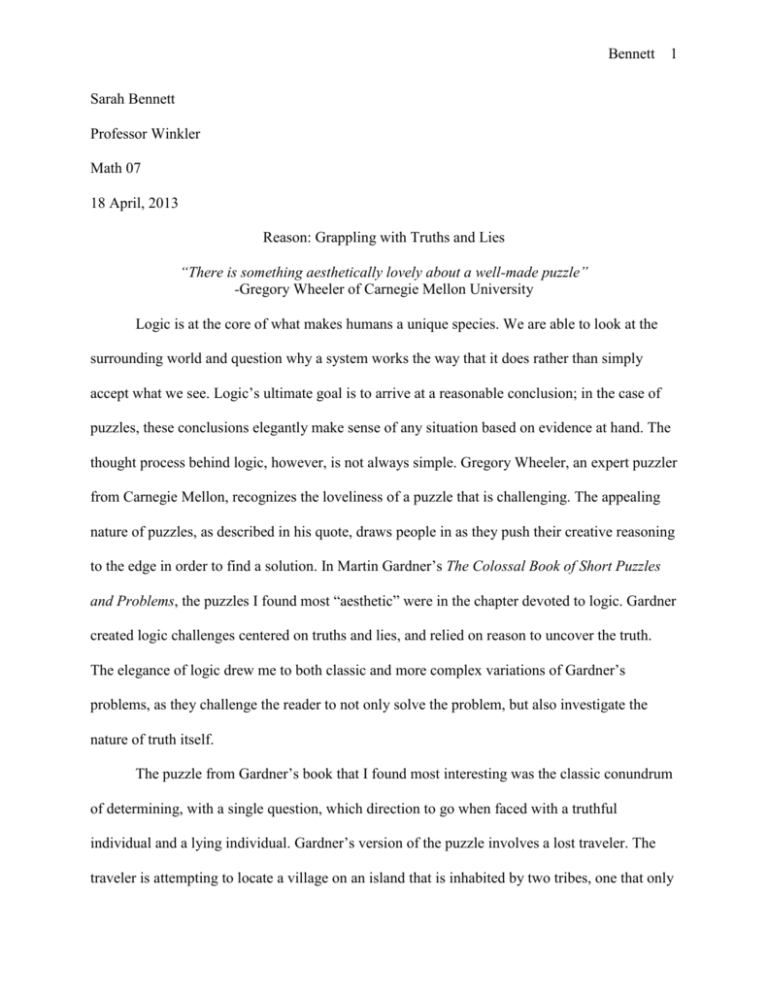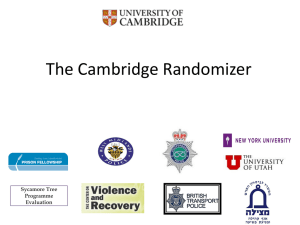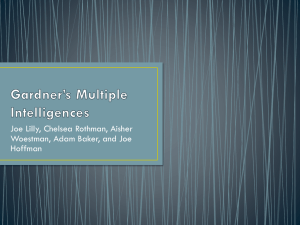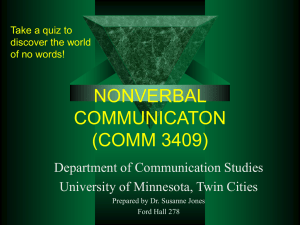Sarah Bennett
advertisement

Bennett 1 Sarah Bennett Professor Winkler Math 07 18 April, 2013 Reason: Grappling with Truths and Lies “There is something aesthetically lovely about a well-made puzzle” -Gregory Wheeler of Carnegie Mellon University Logic is at the core of what makes humans a unique species. We are able to look at the surrounding world and question why a system works the way that it does rather than simply accept what we see. Logic’s ultimate goal is to arrive at a reasonable conclusion; in the case of puzzles, these conclusions elegantly make sense of any situation based on evidence at hand. The thought process behind logic, however, is not always simple. Gregory Wheeler, an expert puzzler from Carnegie Mellon, recognizes the loveliness of a puzzle that is challenging. The appealing nature of puzzles, as described in his quote, draws people in as they push their creative reasoning to the edge in order to find a solution. In Martin Gardner’s The Colossal Book of Short Puzzles and Problems, the puzzles I found most “aesthetic” were in the chapter devoted to logic. Gardner created logic challenges centered on truths and lies, and relied on reason to uncover the truth. The elegance of logic drew me to both classic and more complex variations of Gardner’s problems, as they challenge the reader to not only solve the problem, but also investigate the nature of truth itself. The puzzle from Gardner’s book that I found most interesting was the classic conundrum of determining, with a single question, which direction to go when faced with a truthful individual and a lying individual. Gardner’s version of the puzzle involves a lost traveler. The traveler is attempting to locate a village on an island that is inhabited by two tribes, one that only Bennett 2 speaks the truth, and one that only tells lies. He reaches a fork in his path and notices two villagers, though he is uncertain as to which tribe the each villager belongs. Gardner then asserts that this traveler determines which direction on the path leads to his destination by asking a single question. To solve the puzzle, the reader must determine what the traveler asked in order to know which direction was correct. Gardner proposes a solution that is centered on a single “yes” or “no” question. The traveler points to a path and asks one of the villagers, “If I were to ask you if this road leads to the village, would you say ‘yes’?” Suppose the path does, in fact, lead to the village. If the villager is truthful, he would answer “yes.” Conversely, a liar would say “no” if asked directly if the path leads to the village. The wording of this question, however, forces him to lie and also answer “yes.” If the path the traveler inquires about does not lead to the village, a truthful villager will answer the question “no.” The lying villager would also answer “no” to the question as stated above: if asked directly about the path, he would say it does lead to the village, but when the question in this way he must lie and say he would answer “no.” This logic allows the traveler to discern that any “yes” answer means the path will lead to the village and a “no” answer means he has pointed to the incorrect path. Alternative solutions are also provided in the book. In a similar vein as the first solution, the traveler could pose the question, “If I asked a member of the other tribe whether this road leads to the village, would he say ‘yes’?” If the path is correct, then a liar would know the other villager will answer “yes,” but he must lie and therefore reply “no.” The truthful villager knows that liar would say the correct path did not lead to the village, meaning that the liar would not answer “yes,” so the truthful villager also replies with a “no.” According to this reasoning, then, regardless of to whom the traveler directs his question, the answer will be “no” if he points to the Bennett 3 correct path. Using the opposite of this reasoning, it can be deduced that if the traveler points to the wrong path, then the answer from both the truthful villager and the liar will be “yes.” The satisfaction I get from logic puzzles such as this classic example is derived from arriving at the correct solution. Once one deduces the proper way to navigate the problem, there is a feeling that truth and reason can prevail despite the circumstances. Another large part of my intrigue into this puzzle comes from Gardner’s further discussion of his solution. He includes a letter sent to him from readers in Michigan. This letter takes the problem and applies it to a larger scale. It discusses the assumptions made in the puzzle as to the meaning of truth, and how a human element can change the meaning of a “liar.” The foundation of Gardner’s solution relies on an implied definition of a liar, one that may not be supported in reality. Gardner’s puzzle depends on the liar being an “honest liar,” this means that the villager gives the logical opposite of the truth. For this type of liar to be assumed, it must also be assumed that the liar is able to understand the traveler’s conditional, multi-part questions. Confusion could interfere with the honest liar’s response. In contrast, if the villager were a “simple liar,” he would reply with any statement that is false. This could affect the traveler’s logic, as now he cannot guarantee that his prediction of the liar’s response is correct. The discussion in the letter further examines how the so-called “art of lying” is entirely overlooked in Gardner’s solution. Assuming that these villagers are, in fact, human, the “liar” takes on a different meaning. If the villager is a liar, he aims to deceive with his response. The lying villager, in his quest to confuse the traveler, could respond in any manner that is not truthful or logical, and the traveler could therefore no longer predict the villager’s response. Without logic to guide the traveler through this conundrum, the traveler will remain lost in a sea of uncertainty. Bennett 4 The allure of logic puzzles is enhanced by their universal nature. It is innate for all of mankind to utilize reason; these puzzles simply take this ability and hone the skill. Logic puzzles teach one to think beyond first impression of a problem. Practicing logical thinking pushes the human capacity to think to its limits, as each new variation of a problem presents new challenges. These more difficult problems rely on the same basic principles as the problem discussed previously. By compiling upon what we know, all logic puzzles can be conquered. An extension of the aforementioned puzzle grabbed my attention. Gardner presents a new scenario in which three different men stand in front of you. One man always speaks the truth, one man only tells lies, and one is a “randomizer.” This randomizer can either speak the truth or a lie, and randomly selects his type of response. You do not know which man is which, but the men are aware of how he and his companions will each reply. The objective is to determine which man is which by directing three yes or no questions at any of the men you choose. This problem has two solutions that are each founded upon different reasoning. The answer Gardner publishes lists all the possible combinations of the three men in a table. He labels the three men A, B, and C, and denotes the truthful man with a “T,” the liar with an “L,” and the randomizer with an “R.” A B C T L R T R L L R T L T R R T L R L T Bennett 5 After evaluating all possible combinations of the men, Gardner’s reasoning can be summarized in the following way. He begins by asking A, “Is B more likely to tell the truth than C?” If A replies “yes,” then lines one and four are eliminated. This is because if A is truthful, a liar cannot be more likely to speak the truth than the randomizer. In option four, where A is a liar, he would not give the correct answer that the truthful man will speak the truth more often than the randomizer. By eliminating these two options, one can deduce that C is not the randomizer. If A answers “no” to the first question, then options two and three are eliminated. This is because if A were the truthful man, he would not lie and say that the liar will respond with the truth more than the randomizer. Option three has A as the liar, in which case he would not truthful say the randomizer tells the truth less often than the truthful man. By eliminating options two and three, one can deduce that B is not the randomizer. With the second question, Gardner chooses to ask, “Are you the randomizer?” to the man he knows to not be the randomizer. This question is chosen because both you and the non-randomizing man know that he is not the randomizer. His answer, either truthful or a lie, will then establish his identity. The third question should be once again directed at the non-randomizing man. The third question is, while pointing to one of the non-randomizer’s companions, “Is this man the randomizer?” Depending upon the identity established by the second question, the non-randomizer’s answer can be used to deduce the identities of the two remaining men. This solution was satisfying enough, though I began to wonder if this puzzle could be solved in less than three questions. Could the identities of the three men be determined in one question? I could not solve the puzzles with fewer than three questions, however Gardner cites an alternative solution sent in by one of his readers. This reader’s solution relies on a single question repeated three times. This solution relies again on certain assumptions that once again Bennett 6 open up discussion of what “lying” truly means. The reader suggests that one simply ask each man, “If I were to ask each of your companions if I am wearing a hat and they agree, would your answer agree with theirs?” The truthful man will reply that his answer would not agree to the liar and randomizer who would have to be telling a lie. The liar will say “yes.” The truthful man and randomizer (currently telling the truth) would have a different answer than him, so he lies and says the opposite of his true answer. The interesting aspect of this solution is what would occur when the randomizer is asked this question. He is stuck, for he knows under no conditions would the truthful man and the liar agree when asked the same question. Any reply, then, could be considered a lie. Must the randomizer remain silent? For this solution to work, it is assumed the randomizer is silent as this question is a paradox. This paradox is not explored further in Gardner’s book. I was left to wonder if silence could be considered truth, or simply a lack of truth. Furthermore, was any answer by the randomizer necessarily a lie? Some exploration led me to an article in New Scientist magazine. The article discusses the “World’s Hardest Logic Puzzle.” The puzzle was solved in the 1990’s by George Boolos through a complex series of three-part, conditional questions containing “if and only if” statements (“God”, 50). The puzzle begins with three gods: one a liar, one a truthful god, and one a randomizer. The puzzle also says that a yes or no question must be directed at each of the gods. This sounds familiar to Gardner’s example. There is another added wrench in the world’s hardest puzzle: you do not know the God’s language, and therefore do not know which word means “yes” and which means “no.” The article goes on to explain that the solutions with complex, conditional questions rely on an axiom established by Aristotle. This principle states that any logical statement must be true or false, that there is no middle ground (“God”, 50). The cleverness of Boolos’s solution is that it illuminates the necessity for Aristotle’s principle. Bennett 7 Boolo’s solution demonstrates how difficult logic puzzles become when paradoxes are treated as a “middle ground” level of truth. The article later addresses the issue of the randomizer’s paradox. This occurs when a god is asked a “head exploding” question, one which he is trapped and cannot answer (“God”, 51)? The article cites work done by theorists of “paraconsistent logic,” a type of logic that allows for our own reasoning to accommodate answers that are true contradictions (“God”, 52). This field examines Aristotle’s axiom of the “law of noncontradiction.” This law says that no statement is both true and false. Many have examined the world’s hardest logic puzzle through a paraconsistent lens, hoping to determine the outcome when the randomizer god is permitted to reply even when presented with a “head-exploding” paradox. The solution to the problem under such a condition has yet to be successfully determined. Gardner’s book had both classic and unique variations of logic puzzles that were challenging and answered satisfactorily. The principles of these puzzles can be compounded to create infinite variations of each situation, therefore providing an endless source of intrigue and ways to challenge my own logic skills. There is a human element to these puzzles that makes them more relatable than those that rely solely on mathematical principles. The “art of lying” and what it truly means to lie engages those with a philosophical mindset. Determining what is the truth, a lie, and what occupies a space in between could engage scholars for eternity. Ultimately, it was the irony of the logic puzzles that drew me in the most. It appears that the human ability to reason both solves these puzzles and analyzes them to the point of impossibility. Bennett Work Cited “God, What a Problem.”New Scientist 22 Dec. 2012: 50-52. Print. 8








